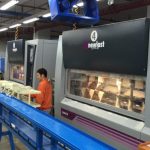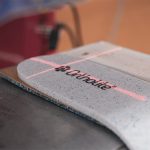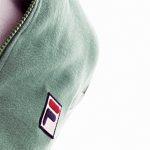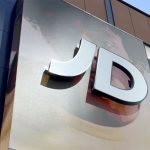Hanesbrands Inc., the parent of Champion, reported third quarter sales of $1.06 billion, down 8% from the year ago period. Earnings soared to $41.1 million, or 43 a share, from $15.9 million, or 17 cents, a year ago. Excluding non-recurring tiems, EPS was $0.63, up 21%.
“Given that we are in the midst of a recession, we had very good profit growth in the quarter and solidified business momentum for 2010,” Hanesbrands Chairman and Chief Executive Officer Richard A. Noll said. “We have built a platform for future growth through our continued brand investments and low-cost global supply chain. We are protecting margins, reducing debt and substantially ramping up our production capacity to support a strong 2010, in which we expect shelf-space and distribution gains to add approximately 5 percent to our sales.”
Noteworthy Financial Highlights
Selected highlights for the quarter ended Oct. 3, 2009, compared with the year-ago quarter ended Sept. 27, 2008, include:
Third-quarter sales were consistent with the company’s previously announced expectations at $1.06 billion, compared with $1.15 billion a year ago. The company increased trade spending, especially for back-to-school programs, to support retailers and position the company for future growth opportunities.
Sales for the Innerwear segment declined by 10 percent with weakness in intimate apparel and socks. Male underwear sales were comparable to last year. Outerwear segment sales decreased by 5 percent with sales strength to retailers, including increased Champion brand activewear sales, offset by lower sales to the wholesale channel.
International segment sales decreased by 8 percent, and Hosiery segment sales declined by 12 percent.
The company’s sales planning assumption continues to be that consumer-spending levels remain constant through 2009.
Operating profit was $93.3 million in the quarter, up from $58.2 million a year ago. Operating profit excluding actions increased by 9 percent to $111.1 million. The operating profit improvement resulted from cost-reduction initiatives and lower commodities.
The third quarter’s operating profit margin excluding actions was 10.5 percent, compared with 8.9 percent in last year’s third quarter.
Diluted EPS increased to $0.43 from $0.17, while diluted EPS excluding
actions increased by 21 percent to $0.63 from $0.52 a year ago.
EPS benefited from higher operating profit and a lower effective income tax rate. The effective income tax rate was 14 percent in the quarter, down from a rate of 24 percent in last year’s quarter. The company expects the tax rate for the year to be 16 percent, reflecting a higher mix of foreign profit due in part to domestic restructuring charges.
Hanesbrands paid down debt by $177 million in the quarter. The company’s debt is now $134 million lower than the beginning of the year, and the company’s goal remains to end the year with debt that is $300 million lower than the start of the year. The company’s strong cash flow is benefiting from reduced inventory.
For 2010, Hanesbrands has the potential for robust cash flow, and its major priority is to pay down debt by another $300 million. The company also continues to consider refinancing its debt as the debt markets allow, possibly as early as the fourth quarter. Refinancing would provide even greater strategic flexibility in 2010 to reduce leverage and consider bolt-on acquisitions that could take advantage of the company’s low-cost global supply chain.
“We continue to invest in our business while reducing debt and expanding margins in a difficult economic environment,” Hanesbrands Executive Vice President and Chief Financial Officer E. Lee Wyatt said. “We also continue to strategically manage our capital structure. The company has set a new long-term leverage ratio target of 2 to 3 times debt to EBITDA, and we have the potential to reach that range in 2011. This would radically change our leverage profile over the next two years.”
(See Table 4 for details and reconciliation with reported operating results consistent with generally accepted accounting principles. Diluted EPS excluding actions, operating profit excluding actions, gross profit excluding actions, SG&A excluding actions, net income excluding actions, EBITDA or earnings before interest, taxes, depreciation and amortization, and the margins on sales of these measures are non-GAAP measures used to better assess underlying business performance because they exclude the effect of unusual actions that are not directly related to operations. The unusual actions in the current or year-ago periods were restructuring and related charges, nonrecurring spinoff-related and other expenses, other expenses, and the tax effect on these items.)
Other Comments
Continued investment in brand-building programs has solidified significant net shelf-space and distribution gains, starting primarily in early 2010. Program gains significantly outnumber program losses, and the company expects the net space gains to generate approximately 5 percent incremental sales growth in 2010. The growth expectation pertains only to the net space and distribution gains and is not dependent on a consumer spending rebound. In early 2010, Hanesbrands will provide its expectations for total 2010 net sales growth based on the space gains, point-of-sale trends for the holiday period, the outlook for the consumer climate in 2010, and other factors.
Hanesbrands is increasing its production capacity to meet 2010 growth expectations. In early October production began at the company’s new Nanjing, China, fabric production plant, which will supply the company’s Southeast Asia sewing facilities. The company is also substantially ramping up contract production as needed.
As a result of the continuing long-term trend of declining sheer hosiery consumption in the United States, the company announced this week that it expects to close a sheer hosiery manufacturing facility in Winston-Salem with 240 employees in 2010.
The company today closed on the previously announced sale of its yarn production plants to Parkdale America, LLC. Exiting yarn production and entering a supply agreement is expected to generate a $100 million balance sheet improvement within six months as a result of working capital improvement and sale proceeds.
“We are pleased with our profit and margin performance and our readiness to take advantage of opportunities in 2010,” Noll said. “This year is playing out consistent with our expectations, and we have continued to invest during the recession. We will begin 2010 with momentum. We have retail shelf-space gains, a recapitalized global supply chain and opportunities for a very good year.”















